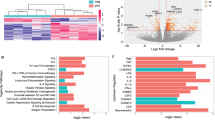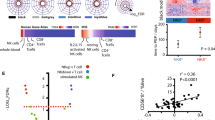Abstract
Intravenous methylprednisolone (IVMP) is the gold standard treatment in acute relapses of multiple sclerosis. Knowing the response to IVMP in advance could facilitate earlier selection of patients for subsequent courses of therapy. However, molecular mechanisms and changes in gene expression induced by methylprednisolone remain unknown. The aim of the study was to identify in vivo differentially expressed genes in relapsing–remitting multiple sclerosis patients after 3–6 days of treatment with IVMP. For this purpose, whole-genome transcription profiling of CD4+ T lymphocytes was performed before and after treatment with IVMP in 8 relapsing–remitting multiple sclerosis patients during relapse using Human GE 4x44K v2 microarrays. Differentially expressed genes were identified using a paired t test on GeneSpring v13.0 software. A P-value <0.001 and a twofold change were considered significant. Microarray data were confirmed using real-time PCR. Microarray revealed changes in gene expression: four genes were downregulated (B3GNT3, ZNF683, IFNG and TNF) and seven upregulated (DEFA4, CTSG, DEFA8P, AZU1, MPO, ELANE and PRTN3). Pathway analysis revealed the transforming growth factor-β signaling pathway to be affected. Comparison with previously published data on in vitro methylprednisolone-regulated genes showed that SMAD7, TNF and CHI3L1 were also downregulated in vivo in relapsing–remitting multiple sclerosis patients. In summary, we performed the first in vivo transcriptome analysis in CD4+ T lymphocytes before and after the treatment with IVMP in patients with multiple sclerosis. Identification of differentially expressed genes in patients receiving IVMP could improve our understanding of the molecular mechanisms underlying the therapeutic effects of IVMP and highlight potential biomarkers of the response to IVMP.
This is a preview of subscription content, access via your institution
Access options
Subscribe to this journal
Receive 6 print issues and online access
$259.00 per year
only $43.17 per issue
Buy this article
- Purchase on Springer Link
- Instant access to full article PDF
Prices may be subject to local taxes which are calculated during checkout


Similar content being viewed by others
References
Kalincik T . Multiple sclerosis relapses: epidemiology, outcomes and management. a systematic review. Neuroepidemiology 2015; 44: 199–214.
Legroux L, Arbour N . Multiple sclerosis and T lymphocytes: an entangled story. J Neuroimmune Pharmacol 2015; 10: 528–546.
Hoppmann N, Graetz C, Paterka M, Poisa-Beiro L, Larochelle C, Hasan M et al. New candidates for CD4 T cell pathogenicity in experimental neuroinflammation and multiple sclerosis. Brain 2015; 138: 902–917.
Sloka JS, Stefanelli M . The mechanism of action of methylprednisolone in the treatment of multiple sclerosis. Mult Scler 2005; 11: 425–432.
Larochelle C, Alvarez JI, Prat A . How do immune cells overcome the blood-brain barrier in multiple sclerosis? FEBS Lett 2011; 585: 3770–3780.
Braitch M, Harikrishnan S, Robins RA, Nichols C, Fahey AJ, Showe L et al. Glucocorticoids increase CD4CD25 cell percentage and Foxp3 expression in patients with multiple sclerosis. Acta Neurol Scand 2009; 119: 239–245.
Xu L, Xu Z, Xu M . Glucocorticoid treatment restores the impaired suppressive function of regulatory T cells in patients with relapsing-remitting multiple sclerosis. Clin Exp Immunol 2009; 158: 26–30.
Momcilović M, Miljković Z, Popadić D, Marković M, Savić E, Ramić Z et al. Methylprednisolone inhibits interleukin-17 and interferon-gamma expression by both naive and primed T cells. BMC Immunol 2008; 9: 47.
Schweingruber N, Fischer HJ, Fischer L, van den Brandt J, Karabinskaya A, Labi V et al. Chemokine-mediated redirection of T cells constitutes a critical mechanism of glucocorticoid therapy in autoimmune CNS responses. Acta Neuropathol 2014; 127: 713–729.
Li S-Y, Wang P, Tang Y, Huang L, Wu Y-F, Shen H-Y . Analysis of methylprednisolone-induced inhibition on the proliferation of neural progenitor cells in vitro by gene expression profiling. Neurosci Lett 2012; 526: 154–159.
Davis TE, Kis-Toth K, Szanto A, Tsokos GC . Glucocorticoids suppress T cell function by up-regulating microRNA-98. Arthritis Rheum 2013; 65: 1882–1890.
Bielecki B, Mazurek A, Wolinski P, Glabinski A . Treatment of multiple sclerosis with methylprednisolone and mitoxantrone modulates the expression of CXC chemokine receptors in PBMC. J Clin Immunol 2008; 28: 122–130.
Airla N, Luomala M, Elovaara I, Kettunen E, Knuutila S, Lehtimäki T . Suppression of immune system genes by methylprednisolone in exacerbations of multiple sclerosis. Preliminary results. J Neurol 2004; 251: 1215–1219.
Kabakchiev B, Turner D, Hyams J, Mack D, Leleiko N, Crandall W et al. Gene expression changes associated with resistance to intravenous corticosteroid therapy in children with severe ulcerative colitis. PLoS One 2010; 5: e13085.
Stelzer G, Inger A, Olender T, Iny-Stein T, Dalah I, Harel A et al. GeneDecks: paralog hunting and gene-set distillation with GeneCards annotation. OMICS 2009; 13: 477–487.
de Andrés C, Tejera-Alhambra M, Alonso B, Valor L, Teijeiro R, Ramos-Medina R et al. New regulatory CD19(+)CD25(+) B-cell subset in clinically isolated syndrome and multiple sclerosis relapse. Changes after glucocorticoids. J Neuroimmunol 2014; 270: 37–44.
Liu WM, Laux H, Henry JY, Bolton TB, Dalgleish AG, Galustian C . A microarray study of altered gene expression in colorectal cancer cells after treatment with immunomodulatory drugs: differences in action in vivo and in vitro. Mol Biol Rep 2010; 37: 1801–1814.
Singhal B. Corticoids in the treatment of multiple sclerosis. In: Oger J, Al-Araji A (eds). Multiple Sclerosis for the Practicing Neurologist. World Federation of Neurology: New York, USA, 2007, pp 59–64.
Navarro J, Aristimuño C, Sánchez-Ramón S, Vigil D, Martínez-Ginés ML, Fernández-Cruz E et al. Circulating dendritic cells subsets and regulatory T-cells at multiple sclerosis relapse: differential short-term changes on corticosteroids therapy. J Neuroimmunol 2006; 176: 153–161.
Nagra RM, Becher B, Tourtellotte WW, Antel JP, Gold D, Paladino T et al. Immunohistochemical and genetic evidence of myeloperoxidase involvement in multiple sclerosis. J Neuroimmunol 1997; 78: 97–107.
Brennan M, Gaur A, Pahuja A, Lusis AJ, Reynolds WF . Mice lacking myeloperoxidase are more susceptible to experimental autoimmune encephalomyelitis. J Neuroimmunol 2001; 112: 97–105.
Williams RN, Paterson CA . Anomalous effects of anti-inflammatory corticosteroids in endotoxin-induced ocular inflammation. Eur J Pharmacol 1984; 106: 113–119.
Zimmer M, Medcalf RL, Fink TM, Mattmann C, Lichter P, Jenne DE . Three human elastase-like genes coordinately expressed in the myelomonocyte lineage are organized as a single genetic locus on 19pter. Proc Natl Acad Sci USA 1992; 89: 8215–8219.
Wan ES, Qiu W, Baccarelli A, Carey VJ, Bacherman H, Rennard SI et al. Systemic steroid exposure is associated with differential methylation in chronic obstructive pulmonary disease. Am J Respir Crit Care Med 2012; 186: 1248–1255.
Stoeckle C, Sommandas V, Adamopoulou E, Belisle K, Schiekofer S, Melms A et al. Cathepsin G is differentially expressed in primary human antigen-presenting cells. Cell Immunol 2009; 255: 41–45.
Han G, Li F, Singh TP, Wolf P, Wang X-J . The pro-inflammatory role of TGFβ1: a paradox? Int J Biol Sci 2012; 8: 228–235.
Monteleone G, Neurath MF, Ardizzone S, Di Sabatino A, Fantini MC, Castiglione F et al. Mongersen, an Oral SMAD7 Antisense Oligonucleotide, and Crohn’s Disease. N Engl J Med 2015; 372: 1104–1113.
Volpe E, Battistini L, Borsellino G . Advances in T Helper 17 Cell Biology: Pathogenic Role and Potential Therapy in Multiple Sclerosis. Mediators Inflamm 2015; 2015: 475158.
Hofman FM, Hinton DR, Johnson K, Merrill JE . Tumor necrosis factor identified in multiple sclerosis brain. J Exp Med 1989; 170: 607–612.
Sharief MK, Hentges R . Association between tumor necrosis factor-alpha and disease progression in patients with multiple sclerosis. N Engl J Med 1991; 325: 467–472.
Selmaj K, Raine CS, Cannella B, Brosnan CF . Identification of lymphotoxin and tumor necrosis factor in multiple sclerosis lesions. J Clin Invest 1991; 87: 949–954.
Arnason B, Jacobs G, Hanlon M, Harding Clay B, Noronha A, Auty A et al. TNF neutralization in MS: results of a randomized, placebo-controlled multicenter study. The Lenercept Multiple Sclerosis Study Group and The University of British Columbia MS/MRI Analysis Group. Neurology 1999; 53: 457–465.
Morís G . Inflammatory bowel disease: an increased risk factor for neurologic complications. World J Gastroenterol 2014; 20: 1228–1237.
Rang EH, Brooke BN, Hermon-Taylor J . Association of ulcerative colitis with multiple sclerosis. Lancet 1982; 2: 555.
Dobson R, Giovannoni G . Autoimmune disease in people with multiple sclerosis and their relatives: a systematic review and meta-analysis. J Neurol 2013; 260: 1272–1285.
Miljković Z, Momcilović M, Miljković D, Mostarica-Stojković M . Methylprednisolone inhibits IFN-gamma and IL-17 expression and production by cells infiltrating central nervous system in experimental autoimmune encephalomyelitis. J Neuroinflammation 2009; 6: 37.
Cantó E, Tintoré M, Villar LM, Costa C, Nurtdinov R, Álvarez-Cermeño JC et al. Chitinase 3-like 1: prognostic biomarker in clinically isolated syndromes. Brain 2015; 138: 918–931.
Miller DH, Khan OA, Sheremata WA, Blumhardt LD, Rice GPA, Libonati MA et al. A controlled trial of natalizumab for relapsing multiple sclerosis. N Engl J Med 2003; 348: 15–23.
Wilson EH, Weninger W, Hunter CA . Trafficking of immune cells in the central nervous system. J Clin Invest 2010; 120: 1368–1379.
Wang X, Ma C, Wu J, Zhu J . Roles of T helper 17 cells and interleukin-17 in neuroautoimmune diseases with emphasis on multiple sclerosis and Guillain-Barré syndrome as well as their animal models. J Neurosci Res 2013; 91: 871–881.
Acknowledgements
We are grateful to the study patients for their participation. The study was supported by ‘Programa Miguel Servet II MSII13/00008’ (LALF), co-financed by ERDF (FEDER) Funds from the European Commission, ‘A way of making Europe’ and by MINECO PTA2013-8539-I (MIG).
Author information
Authors and Affiliations
Corresponding author
Ethics declarations
Competing interests
The authors declare no conflict of interest.
Additional information
Supplementary Information accompanies the paper on the The Pharmacogenomics Journal website
Supplementary information
PowerPoint slides
Rights and permissions
About this article
Cite this article
De Andres, C., García, M., Goicoechea, H. et al. Genes differentially expressed by methylprednisolone in vivo in CD4 T lymphocytes from multiple sclerosis patients: potential biomarkers. Pharmacogenomics J 18, 98–105 (2018). https://doi.org/10.1038/tpj.2016.71
Received:
Revised:
Accepted:
Published:
Issue Date:
DOI: https://doi.org/10.1038/tpj.2016.71



